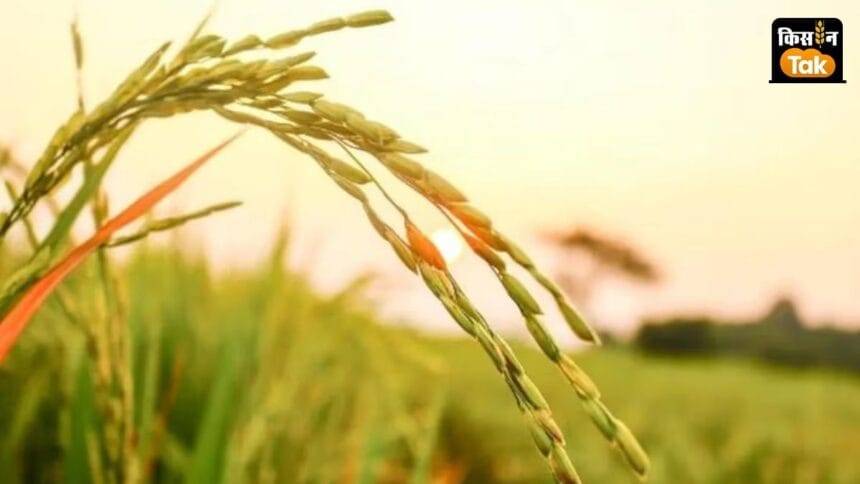Main Points In Hindi (मुख्य बातें – हिंदी में)
-
पैड की बुवाई में रिकॉर्ड वृद्धि: इस खारीफ मौसम में किसानों ने पैड की बुवाई में बहुत अधिक वृद्धि की है, जिसके परिणामस्वरूप कृषि मंत्रालय के आंकड़ों के अनुसार क्षेत्र में लगभग 8 लाख हेक्टेयर की वृद्धि दर्ज की गई है।
-
सर्वेक्षण के डेटा में असमानता: कृषि मंत्रालय द्वारा किए गए मैनुअल सर्वेक्षण में 10 लाख हेक्टेयर की वृद्धि दिखी है, जबकि डिजिटल फसल सर्वेक्षण ने 65 लाख हेक्टेयर की अधिक बुवाई की पुष्टि की है, जिससे पैदावार के पहले अनुमान में देरी हो रही है।
-
सरकार का सतर्क दृष्टिकोण: पैदावार के पहले अनुमान को सावधानी से जारी किया जा रहा है, क्योंकि कृषि मंत्रालय के अधिकारियों ने बताया है कि क्षेत्र और उत्पादन का सत्यापन करना आवश्यक है।
-
पैदावार बढ़ने के कारण: पैड की बुवाई में वृद्धि के दो प्रमुख कारण बताए गए हैं: एक तो पैड के बाजार मूल्य में वृद्धि और दूसरा अच्छे मौसम व वर्षा की स्थिति है।
- अन्य फसलों में गिरावट: पैड की बुवाई में वृद्धि का एक प्रभावयह भी है कि कुछ अन्य फसलों जैसे कपास और बाजरा के क्षेत्र में गिरावट आई है, जिससे कपास और बाजरा के किसान पैड की खेती की ओर शिफ्ट हो रहे हैं।
Main Points In English(मुख्य बातें – अंग्रेज़ी में)
Here are the main points from the text regarding the Kharif season paddy sowing:
-
Record Increase in Sown Area: The area under paddy cultivation for the Kharif season has seen a significant increase, with estimates showing a rise of about 8 lakh hectares compared to the previous year. The digital crop survey indicates an increase of 65 lakh hectares.
-
Discrepancy in Survey Data: There are conflicting results between manual and digital surveys conducted by the Agriculture Ministry, which has led to a delay in the release of the first estimate of paddy production. The manual survey reported an increase of 10 lakh hectares.
-
Cautious Estimation Approach: The government is exercising caution in releasing production estimates due to the discrepancies in survey data. Typically, these estimates are released in the third week of September, but this year’s has been postponed.
-
Factors Contributing to Increased Area: The rise in paddy cultivation is attributed to two key factors: an increase in the market price of paddy and favorable weather conditions, including good rainfall.
- Shift from Other Crops: The increase in paddy area has resulted in a decline in the cultivation of other crops, such as cotton and millet, as farmers, particularly in regions like Punjab, shift toward paddy farming.


Complete News In Hindi(पूरी खबर – हिंदी में)
इस खरीफ मौसम में किसानों ने अधिक मात्रा में धान की बुआई की है, जिसके कारण क्षेत्र में रिकॉर्ड वृद्धि हुई है। कृषि मंत्रालय द्वारा 27 सितंबर को जारी किए गए आंकड़ों के अनुसार, पिछले वर्ष की तुलना में लगभग 8 लाख हेक्टेयर की वृद्धि हुई है। कृषि मंत्रालय द्वारा किए गए मैनुअल सर्वे में 10 लाख हेक्टेयर की वृद्धि दर्ज की गई है। वहीं, डिजिटल फसल सर्वे में 65 लाख हेक्टेयर में अधिक धान की बुआई की जानकारी मिली है। इन दोनों प्रकार के सर्वेक्षणों के विभिन्न आंकड़ों के कारण धान उत्पादन का पहला अनुमान जारी करने में देरी हो रही है।
कृषि मंत्रालय के डिजिटल फसल सर्वे के अनुसार, इस वर्ष खरीफ धान का क्षेत्र पिछले वर्ष के 407 लाख हेक्टेयर की तुलना में 65 लाख हेक्टेयर अधिक है। पिछले 5 वर्षों में धान का औसत क्षेत्र 401.6 लाख हेक्टेयर रहा है। अब, धान की बुआई में वृद्धि को देखते हुए, सरकार पहले उत्पादन का अनुमान लगाने में बहुत सतर्क है। आमतौर पर, अनुमान सितंबर के तीसरे सप्ताह में जारी किए जाते हैं, लेकिन अभी तक अनुमान जारी नहीं हुआ है।
सर्वेक्षण डेटा में भिन्नता के कारण उत्पादन अनुमानों में देरी
कृषि मंत्रालय के एक वरिष्ठ अधिकारी ने कहा कि फसल अनुमान जारी करने में देरी क्षेत्र में वृद्धि के मुद्दे से संबंधित नहीं है और यह जल्द ही जारी किया जाएगा। अधिकारी ने कहा कि जब सभी इनपुट्स, जिसमें क्षेत्र और डिजिटल सर्वे शामिल हैं, को ध्यान में रखा जाएगा तो क्षेत्र और उत्पादन ज्ञात होगा। मीडिया रिपोर्ट में एक अधिकारी के स्रोत के हवाले से कहा गया है कि डिजिटल फसल सर्वे को पायलट आधार पर किया गया है और इसे धीरे-धीरे अपनाया जाएगा। हालांकि, उत्पादन अनुमान की महत्वता को देखते हुए, सरकार डिजिटल कृषि पर ध्यान केंद्रित कर रही है और फसल सर्वे इसका एक हिस्सा है।
मैनुअल सर्वे में 10 लाख हेक्टेयर का क्षेत्र बढ़ा
कृषि मंत्रालय क्षेत्र में बढ़ती धान की बुआई पर विशेषज्ञों के साथ चर्चा कर रहा है, क्योंकि मैनुअल सर्वे में केवल 10 लाख हेक्टेयर की वृद्धि दिखाई गई है। जबकि, डिजिटल सर्वे में 65 लाख हेक्टेयर की वृद्धि मिली है। 27 सितंबर को साप्ताहिक फसल मौसम निगरानी समूह ने खरीफ धान के तहत फसल क्षेत्र का अनुमान 414.5 लाख हेक्टेयर लगाया, जो पिछले वर्ष 404.5 लाख हेक्टेयर था।
धान के क्षेत्र में वृद्धि के लिए दो कारण
धान के क्षेत्र में वृद्धि के लिए दो कारण बताए जा रहे हैं। पहला, धान के बाजार मूल्य में वृद्धि और दूसरा, फसल के लिए अच्छी बारिश और अनुकूल मौसम। कृषि विज्ञानियों का कहना है कि जब बारिश अच्छी होती है, तो किसान ऊंचाई वाले क्षेत्रों में भी धान की बुआई करते हैं। हालांकि, कपास और बाजरे जैसे कुछ फसलों के क्षेत्र में कमी को भी धान की बुआई में वृद्धि से जोड़ा जा रहा है और माना जा रहा है कि पंजाब जैसे अन्य राज्यों के कपास और बाजरे के किसान धान की खेती की ओर रुख कर रहे हैं।
और पढ़ें –
Complete News In English(पूरी खबर – अंग्रेज़ी में)
In this Kharif season, farmers have sown paddy extensively, due to which a record jump has been recorded in the area. The data of the Agriculture Ministry released on September 27 shows an increase of about 8 lakh hectares compared to last year. In the manual survey conducted by the Agriculture Ministry, the area has been reported to have increased by 10 lakh hectares. Whereas, the digital crop survey has revealed excess paddy sowing in 65 lakh hectares. Due to different data from both types of surveys, there is said to be a delay in releasing the first estimate of paddy production.
According to the Digital Crop Survey of the Ministry of Agriculture, the area under Kharif paddy this year is believed to be 65 lakh hectares more than last year’s 407 lakh hectares. The average area under paddy in the last 5 years has been 401.6 lakh hectares. Now, in view of the increase in paddy sowing this season, the government is very cautious in making the first estimate of production. Generally estimates are released in the third week of September. But, the estimate has not been released yet.
Delay in production estimates due to difference in survey data
A senior Agriculture Ministry official said that the delay in releasing the crop estimate has nothing to do with the issue of increase in area and it will be released soon. The official said the area and production will be known when the estimates are finalized after considering all inputs including field and digital surveys. In the media report, quoting an official source, it was said that the digital crop survey has been done on a pilot basis. It will be adopted gradually. However, considering the importance of production estimation, the government is focusing on digital agriculture and crop survey is a part of it.
Area increased by 10 lakh hectares in manual survey
The Agriculture Ministry is discussing the increasing area under paddy with experts, as the manual survey had shown it to be only 10 lakh hectares more. Whereas, in the digital survey, the area has been found to be increased by 65 lakh hectares. The weekly crop weather monitoring group on September 27 had estimated the crop area under Kharif paddy at 414.5 hectares, compared to 404.5 hectares a year ago.
Two reasons for increasing paddy area
Two reasons are being given for the increase in paddy area. Firstly, the increase in the market price of paddy is being considered. While the second reason has been cited as good rain and favorable weather for the crop. Agricultural scientists said that when the rains are good, farmers sow paddy even in high altitude areas. However, the decline in the area of some crops including cotton and millet is also being linked to the increase in paddy cultivation and it is believed that cotton and millet farmers of other states including Punjab have shifted to paddy cultivation.




